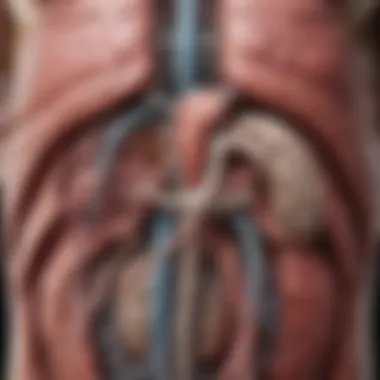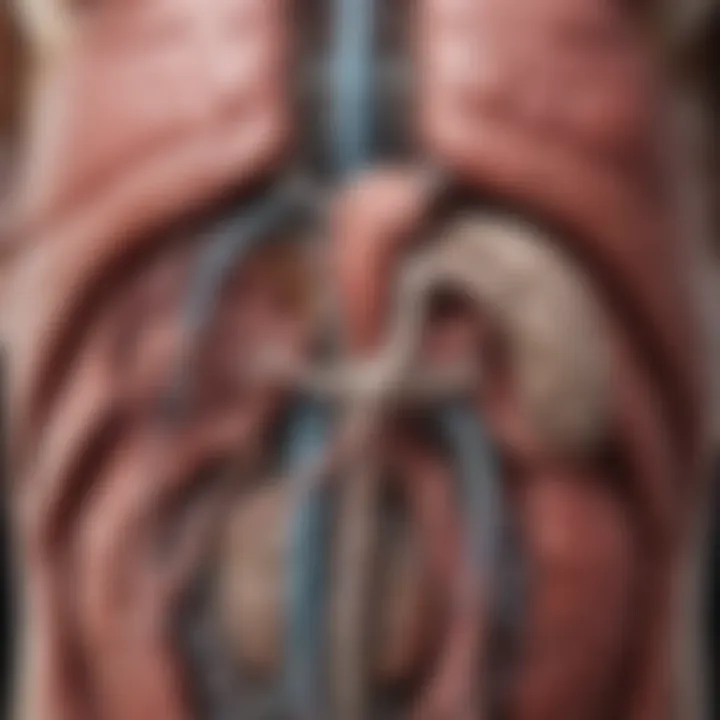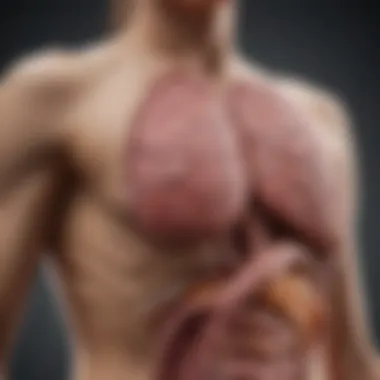Gastrohepatic Interactions: Gastroenterology & Hepatology


Intro
Gastrohepatic interactions encompass the complex and vital connections between gastroenterology and hepatology. These two areas of medicine focus on the digestive system and liver health, respectively. Understanding how they intersect is essential for managing diseases that affect both systems. Research in this field has increased its relevance in clinical practice, highlighting the need for integrated approaches to improve treatment outcomes. This article aims to delve into the anatomy and physiology of the gastrohepatic system while discussing key disorders and treatment strategies.
Article Overview
Summary of Key Findings
The exploration of gastrohepatic interactions reveals several significant insights. First, these interactions influence a wide range of gastrointestinal and liver diseases. Chronic liver conditions can lead to alterations in intestinal function, impacting nutrient absorption and increasing susceptibility to infections. Conversely, gastrointestinal disorders can exacerbate liver diseases by affecting hepatic blood flow and metabolic pathways. A holistic view that includes both gastroenterological and hepatological perspectives is essential.
Research Objectives
The main objectives of this research are to:
- Investigate the anatomical and physiological connections between the gastrointestinal tract and liver.
- Highlight common diseases that illustrate these connections.
- Assess the implications of a comprehensive approach to diagnosis and treatment in improving patient care.
Key Results and Discussions
Main Findings
Several key findings emerged from this investigation:
- There is a bidirectional relationship between liver health and gut function. Conditions like cirrhosis can lead to symptoms such as esophageal varices, while gastrointestinal inflammation can promote liver injury.
- The gut microbiota plays a crucial role in metabolic processes that affect liver health. Dysbiosis can result in inflammation and liver disease progression.
- Integrative treatment strategies that address both the gastrointestinal and hepatic systems tend to yield better outcomes for patients with conditions affecting both areas.
Implications of Findings
The implications of these findings are profound:
- Patient Management: A coordinated approach to treatment can optimize outcomes for patients suffering from related gastrointestinal and liver conditions.
- Clinical Practice: Physicians should consider referral pathways and collaborative strategies in treating patients with overlap between these specialties.
- Future Research: Further studies are necessary to explore novel therapeutic options that address the holistic needs of affected patients.
"Understanding the connections between different organs is no longer optional; it is the foundation of effective medical care."
Prolusion to Gastrohepatic Interactions
Understanding gastrohepatic interactions is critical for anyone involved in the fields of gastroenterology and hepatology. These interactions form a significant aspect of patient management and treatment effectiveness. The complexities of these two systems require a thorough examination, which helps uncover how disorders in one can affect the other. Such insights can inform better treatment strategies, ultimately enhancing patient outcomes.
The gastrohepatic axis consists of neural, hormonal, and vascular connections. These pathways link the gastrointestinal tract and the liver, signifying their partnership in maintaining homeostasis and accompanying metabolic functions. Disruptions within this axis can lead to various disorders, highlighting the need to approach treatment through a comprehensive lens. This article will delve deep into components that define gastrohepatic interactions, ensuring that the interconnected nature of these fields is understood thoroughly.
Defining Gastroenterology and Hepatology
Gastroenterology focuses on the digestive system, addressing conditions that affect the gastrointestinal tract, such as irritable bowel syndrome, gastroesophageal reflux disease, and gastrointestinal cancers. It encompasses the functions of organs including the esophagus, stomach, pancreas, intestines, and rectum. This field emphasizes dietary aspects, absorption, and the interplay of gut microbiota in digestive health.
In contrast, hepatology is a subspecialty of gastroenterology concentrating specifically on diseases of the liver, gallbladder, biliary tree, and pancreas. It handles conditions such as hepatitis, cirrhosis, and fatty liver disease. Understanding hepatology’s focus allows specialists to better address liver-related issues that may arise within gastrointestinal conditions. Both fields, while distinct, are interrelated and often overlap, necessitating collaboration and a unified approach to patient care.
Overview of the Gastrohepatic Axis
The gastrohepatic axis involves multiple systems that link the gastrointestinal tract and the liver. This axis plays a vital role in processing nutrients and drugs, facilitating detoxification, and regulating metabolic pathways. Notably, the portal circulation transports blood from the gastrointestinal organs to the liver, allowing for efficient nutrient uptake and potential processing of toxins.
Disruption in this axis can lead to conditions such as hepatic encephalopathy or metabolic disorders. Therefore, understanding its functioning helps clinicians diagnose and manage patients effectively.
Key factors regarding the gastrohepatic axis include:
- Neural Connections: The autonomic nervous system regulates digestive processes and liver functions, coordinating responses to food intake.
- Hormonal Signals: Hormones like insulin and glucagon play crucial roles in metabolic regulation between the liver and the digestive system.
- Vascular Pathways: The hepatic portal vein is crucial as it allows nutrient-rich blood to reach the liver post-absorption, showcasing the direct link between gut health and liver functionality.
Anatomy and Physiology of the Gastrohepatic System


Understanding the anatomy and physiology of the gastrohepatic system is essential in revealing the intricate connections between the digestive system and liver functions. The interplay between these two systems has profound implications for both gastrointestinal and hepatic health. Consequently, recognizing this relationship can enhance patient management strategies and treatment outcomes in both fields.
The Digestive Tract and Its Functions
The digestive tract is a complex sequence of organs, beginning at the mouth and extending to the anus. It includes the esophagus, stomach, small intestine, and large intestine. Each part plays a distinct role in breaking down food, absorbing nutrients, and expelling waste.
- Mouth: Saliva begins the digestive process, with enzymes helping to break down carbohydrates.
- Stomach: It churns food and mixes it with gastric juices, turning it into a semi-liquid form called chyme.
- Small Intestine: Here, the majority of nutrient absorption occurs. Digestive enzymes from the pancreas and bile from the liver help digest food.
- Large Intestine: Responsible for water absorption and waste formation, leading to excretion.
This organized process shows how the digestive tract operates not just in isolation but also in conjunction with the liver, which produces bile, a substance necessary for fat digestion and absorption.
The Liver: Central Role in Metabolism
The liver is often described as the body's metabolic hub. It processes nutrients absorbed from the digestive tract via the hepatic portal circulation. This organ plays several crucial roles:
- Metabolism of Carbohydrates: The liver converts excess glucose into glycogen for storage and releases glucose when needed.
- Lipid Metabolism: It synthesizes fatty acids and cholesterol and participates in fat storage.
- Protein Synthesis: The liver produces crucial proteins such as albumin and clotting factors.
- Detoxification: It neutralizes harmful substances, such as drugs and alcohol.
The liver's multifaceted functions highlight its importance in the gastrohepatic system. A disfunction in liver operations can significantly affect digestion and general metabolism, illustrating how closely tied these functions are.
Vascular Connections: Portal Circulation
The vascular architecture of the gastrohepatic system is vital. The portal vein is a key vessel that transports blood from the gastrointestinal tract and spleen to the liver. This mechanism allows the liver to process and filter nutrients before they enter the systemic circulation.
- Hepatic Portal System: This system ensures that the liver can receive nutrients directly from the intestinal tract, enabling efficient metabolism and detoxification.
- Dual Blood Supply: The liver receives blood from both the hepatic artery and the portal vein. This dual supply ensures that the liver remains well-nourished and capable of performing its functions effectively.
The portal circulation is integral to understanding liver diseases and their gastrointestinal manifestations. Disturbances in this system can lead to significant clinical conditions, such as portal hypertension, which may cause serious complications.
The connection between the digestive system and the liver underlines the importance of a comprehensive approach in diagnosing and treating associated disorders.
In summary, the anatomy and physiology of the gastrohepatic system reveal the essential relationship between digestion and liver functions. Recognizing this interplay is critical for accurate diagnosis, effective treatment strategies, and ultimately better health outcomes for patients.
Common Gastrohepatic Disorders
Understanding common gastrohepatic disorders is essential for recognizing the complex interplay between gastrointestinal and hepatic health. The liver and gastrointestinal tract do not function in isolation; their interactions can influence clinical symptoms, disease progression, and treatment outcomes. Addressing these disorders requires insight into their multifaceted nature, as the pathophysiological mechanisms often overlap. This section details prevalent gastrohepatic conditions, emphasizing their clinical importance and the need for integrated management strategies.
Chronic Liver Disease and Its Gastrointestinal Manifestations
Chronic liver disease (CLD) encompasses a range of conditions resulting in prolonged liver dysfunction. One aspect often overlooked is its impact on the gastrointestinal system. Patients may experience symptoms like nausea, abdominal pain, and changes in bowel habits. These gastrointestinal manifestations can indicate a worsening liver condition or lead to significant complications such as portal hypertension, which may provoke esophageal varices or ascites.
Despite the liver's roles in detoxification and metabolism, gastrointestinal symptoms often obscure liver dysfunction until it reaches a critical stage. By recognizing these signs early, healthcare providers can initiate appropriate diagnostic evaluations, leading to timely interventions that can alter disease trajectories.
Hepatitis and Enteric Infections
Hepatitis, an inflammation of the liver, can be acute or chronic, and stems from various causes, including viral infections, alcohol abuse, and autoimmune disorders. One of the relevant aspects of hepatitis is the risk of concurrent enteric infections, particularly in immunocompromised patients. The liver plays a vital role in immune response, and its dysfunction can heighten the susceptibility to gastrointestinal pathogens.
In cases of hepatitis, the liver's impaired function can lead to alterations in bile flow, impacting digestion and nutrient absorption. Overall, understanding the relationship between hepatitis and gastrointestinal infections enables healthcare professionals to devise effective treatment plans and incorporate preventive measures against potential infections.
Cirrhosis: A Gastrohepatic Perspective
Cirrhosis represents the end stage of chronic liver disease, characterized by irreversible scarring of liver tissues. From a gastrohepatic standpoint, cirrhosis generates several complications that significantly affect both liver and gastrointestinal functioning. Portal hypertension, ascites, and hepatic encephalopathy are prevalent issues that stem from cirrhotic transformations.
As cirrhosis progresses, its effects on the digestive tract manifest through symptoms like malnutrition, gastrointestinal bleeding, and infectious complications. Clinically addressing cirrhosis involves not only managing liver function but also recognizing and treating its gastrointestinal ramifications, which can improve the overall prognosis of patients.
Inflammatory Bowel Disease and Its Hepatic Complications
Inflammatory bowel disease (IBD), which includes Crohn’s disease and ulcerative colitis, further exemplifies the relationship between gastroenterology and hepatology. Patients with IBD are at risk of developing liver disorders, including primary sclerosing cholangitis. Symptoms related to liver dysfunction in IBD patients often necessitate careful monitoring and management.
The interplay between these conditions can complicate treatment approaches. For instance, the use of immunosuppressive therapies for managing IBD might exacerbate hepatic complications. Understanding these dynamics underscores the importance of a comprehensive assessment to effectively address the needs of patients with concurrent gastrohepatic disorders.


Diagnostic Approaches in Gastrohepatic Disorders
Understanding the diagnostic approaches in gastrohepatic disorders is crucial for effective patient management. These diagnostics not only aid in identifying conditions that may be present but also help in monitoring disease progression. Given the complex interaction between the gastrointestinal tract and the liver, comprehensive diagnostic strategies must be employed to achieve accurate results. This section will explore the main techniques used to diagnose gastrohepatic disorders, emphasizing their benefits, considerations, and significance in clinical practice.
Endoscopy and Liver Imaging Techniques
Endoscopy plays a pivotal role in the diagnosis of various gastrohepatic disorders. Through esophagogastroduodenoscopy, clinicians can directly visualize the upper gastrointestinal tract. This technique is essential for identifying mucosal lesions, varices, and signs of inflammation or infection. It allows for both diagnosis and therapeutic interventions, such as the treatment of bleeding varices.
Furthermore, enteroscopy can assess the small intestine. It’s particularly valuable if patients exhibit obscure gastrointestinal bleeding or suspected small bowel pathology. This visual access helps guide management decisions based on direct observations.
Liver imaging techniques, such as ultrasound, computed tomography (CT), and magnetic resonance imaging (MRI), play significant roles as well. These methods allow for the assessment of liver structure, identifying abnormalities such as tumors, abscesses, or nodules. Ultrasound is often the first-line imaging technique due to its accessibility and lack of ionizing radiation. CT scans provide more detailed images and can be useful in staging liver diseases. MRI, although more expensive and less available, offers superior contrast resolution, particularly in liver lesions.
In summary, endoscopic and imaging techniques provide comprehensive insights into gastrohepatic disorders. They allow for effective diagnosis and subsequent management, making them indispensable in clinical practice.
Biochemical Markers of Liver Function
Biochemical markers serve as essential components in the diagnostic workup of gastrohepatic disorders. These markers help assess liver function and detect hepatic injury. The liver plays a central role in various metabolic processes; thus, its dysfunction can have systemic implications.
The most commonly tested biochemical markers include:
- Alanine aminotransferase (ALT): Elevated levels indicate liver cell injury.
- Aspartate aminotransferase (AST): While AST is also indicative of liver injury, it's not liver-specific, thus needs to be interpreted in relation to ALT levels.
- Alkaline phosphatase (ALP): Increased levels may signal cholestasis or biliary obstruction.
- Bilirubin: High levels can point to hepatic dysfunction or hemolysis.
The interpretation of these markers requires careful consideration of a patient's clinical context. A thorough understanding of the patterns and ratios of these enzymes allows for differentiation between various types of liver disease, such as viral hepatitis, alcoholic liver disease, or non-alcoholic fatty liver disease.
"Accurate and timely diagnosis is essential for effective management of gastrohepatic disorders, influencing patient outcomes significantly."
Therapeutic Strategies in Managing Gastrohepatic Conditions
Gastrohepatic conditions present complex challenges for clinicians. Understanding the therapeutic strategies in managing these conditions is vital. This section examines three primary approaches: pharmacological treatments, surgical interventions, and nutritional support. Each strategy has its unique elements, benefits, and considerations. Integrating these strategies into patient management can improve overall treatment outcomes.
Pharmacological Treatments
Pharmacological treatments are often the first line of defense in managing gastrohepatic conditions. They aim to address specific symptoms or underlying pathologies. Treatments may include medications such as
- Antiviral agents for hepatitis
- Diuretics for fluid retention in liver disease
- Proton pump inhibitors for managing acid-related gastrointestinal issues
These medications can effectively manage symptoms and improve liver function. Careful monitoring of each patient's response is important to tailor the treatment accordingly. The choice of medication often depends on individual patient factors, including their liver function and overall health status. Adverse drug reactions must also be considered, as they can complicate treatment.
"The effective use of pharmacological treatments can significantly enhance the quality of life for patients with gastrohepatic disorders."
Surgical Interventions: When Are They Necessary?
Surgical interventions may be required when pharmacological treatments are insufficient. They can be critical in cases of severe liver disease, perforated ulcers, or obstruction in the digestive tract. Common surgical procedures include:
- Liver resection or transplantation for significant liver dysfunction
- Biliary bypass for obstructed bile ducts
- Surgery for conditions like pancreatitis or cancer impacting the gastrointestinal system
Decisions about surgery are complex and hinge on multiple factors. These factors include the nature of the disease, the patient's general health, and potential risks associated with surgery. Surgical strategies must be applied judiciously, ensuring they are truly warranted by the patient's condition and not merely a deficiency in pharmacological management.
Nutritional Support in Hepatic and Gastrointestinal Diseases
Nutritional support plays a critical yet often overlooked role in managing gastrohepatic conditions. Proper nutrition can help mitigate some symptoms and improve recovery outcomes. Patients with liver disease may experience malnutrition due to:
- Increased energy expenditure associated with liver disease
- Inadequate protein intake
- Impaired nutrient absorption
Nutritional support might include:
- Tailored diets that are high in carbohydrates and low in fats for those with liver impairment
- Nutrient-rich supplements to provide essential vitamins and minerals
- Enteral or parenteral nutrition in severe cases—especially where oral intake is not feasible


Education about dietary adjustments can empower patients. It also leads to better adherence to treatment. Collaborating with a nutritionist can further enhance the effectiveness of nutritional support.
Holistic Approaches in Patient Management
Holistic approaches in patient management are increasingly important in the context of gastrohepatic interactions. Such strategies emphasize treating the patient as a whole, rather than focusing solely on individual symptoms or diseases. Integrating gastroenterology and hepatology not only improves treatment outcomes but also enhances the overall patient experience.
This integrated perspective recognizes that gastrointestinal health and liver function are deeply interconnected. For instance, a patient presenting with gastrointestinal symptoms may have underlying hepatic issues, and vice versa. A holistic approach considers these links and encourages the collaboration of multidisciplinary teams, resulting in comprehensive care tailored to individual needs.
Multidisciplinary Care Models
Multidisciplinary care models play a crucial role in holistic patient management. These models involve collaboration among various healthcare professionals, including gastroenterologists, hepatologists, nutritionists, and mental health specialists. Each professional contributes unique expertise, which can lead to more informed decision-making regarding patient care.
In practice, a patient with inflammatory bowel disease may require input not only from their gastroenterologist but also from a hepatologist, especially if liver function tests indicate potential complications. This approach ensures that all aspects of a patient’s health are addressed, reducing the risk of oversight and increasing the quality of care.
Benefits of multidisciplinary care models:
- Comprehensive diagnosis: Different specialists can catch complex interactions that may be missed by a single physician.
- Customized treatment plans: These teams can create treatment strategies that take into account all aspects of a patient's health.
- Enhanced patient support: Patients benefit from a more coordinated and empathetic healthcare experience.
Importance of Patient Education
Patient education is vital in managing gastrohepatic conditions. Understanding one's health status and the nature of their diseases empowers patients. Educated patients are more likely to adhere to treatment plans and actively engage in their healthcare decisions.
Key aspects of effective patient education include:
- Clear communication: Providers should explain conditions and treatments in a way that is easily understandable, avoiding medical jargon where possible.
- Resource availability: Providing patients with literature or access to support groups can facilitate their understanding and help them feel less isolated.
- Regular follow-ups: Continuous education through follow-up appointments can reinforce learning and address any questions that may arise over time.
"Educated patients are more likely to adhere to treatment plans and actively engage in their healthcare decisions."
Future Directions in Gastrohepatic Research
Gastrohepatic research is continually evolving, emphasizing the necessity for modern approaches to understanding the complex interconnections between gastroenterology and hepatology. New findings in this interdisciplinary field can directly impact clinical practices, leading to improved patient outcomes and management strategies. Understanding these future directions is crucial for professionals who seek to enhance their knowledge and application in treating gastrohepatic disorders.
Emerging Therapies and Innovations
Recent advancements in medical science have pointed towards several exciting therapies and innovations. These include:
- Biologic treatments targeting specific inflammatory pathways associated with liver and gastrointestinal diseases. These therapies have shown promise in conditions like inflammatory bowel disease and chronic liver diseases, offering new angles for intervention.
- Gene therapy, which aims to correct genetic defects influencing conditions such as autoimmune liver diseases. This can potentially revolutionize treatment options, providing long-lasting solutions rather than symptom management.
- Microbiome research, exploring the gut-liver axis and its role in health and disease. Adjustments to gut microbiota through diet, probiotics, or prebiotics have begun to show positive effects on liver health, opening up new therapeutic strategies.
The integration of emerging therapies provides healthcare professionals with expanded options to tailor treatments, ultimately improving quality of life for patients.
The Role of Genetics in Gastrohepatic Disorders
Genetics plays a significant role in understanding the etiology of various gastrohepatic disorders. Research is revealing how genetic predispositions contribute to the development of diseases such as fatty liver disease and certain types of hepatitis. Key points include:
- Identifying genetic markers could enhance the precision of diagnosis and help in the early identification of at-risk patients. This aids in timely intervention and personalized treatment plans.
- Pharmacogenomics is an area of focus, studying how genetic variations affect individual responses to drugs used in treating liver and gastrointestinal issues. Optimizing therapy based on genetic makeup may increase efficacy and reduce adverse effects.
- Hereditary conditions such as hemochromatosis and Wilson's disease significantly affect liver function and require genetics-based approaches for accurate diagnosis and management strategies.
Ending
The conclusion offers a critical synthesis of the previous sections, emphasizing the importance of integrating gastroenterology and hepatology. This integration is essential for effective patient management and treatment outcomes. As the boundaries between these two specialties often blur, understanding their interconnectedness becomes vital for healthcare providers.
Integrating Gastroenterology and Hepatology for Improved Outcomes
Integrating the knowledge and practices of gastroenterology and hepatology leads to better clinical outcomes for patients. One of the main benefits of this integration is a more comprehensive diagnostic approach. Patients presenting with gastrointestinal symptoms may also have underlying liver conditions, and vice versa. By recognizing these connections, healthcare professionals can conduct more thorough evaluations.
Effective collaboration between specialists can streamline treatment protocols. A multidisciplinary team can create individualized treatment plans, accounting for both gastrointestinal and hepatic health. This approach is particularly important in managing chronic conditions like hepatitis and cirrhosis, where complications can arise in both systems.
Consideration of nutritional management also plays a key role in integrated care. Nutritional deficiencies are common in patients with gastrohepatic disorders, and addressing these can improve overall health and recovery. Ensuring appropriate dietary planning is essential in this context.
Importantly, patient education must not be overlooked. Patients who understand their conditions in a holistic manner are more likely to engage in their own care. They become informed participants rather than passive recipients of treatment, which can lead to better adherence to therapeutic regimens.
"The integration of gastroenterology and hepatology is not just about treatment but also about understanding the entire patient journey."
In summary, the integration of gastroenterology and hepatology fosters a comprehensive approach to patient care. It allows for a unified strategy towards diagnosis, treatment, and education, ultimately leading to better health outcomes. As these fields continue to evolve, the emphasis on collaboration and holistic management will likely set the standard for future clinical practice.







